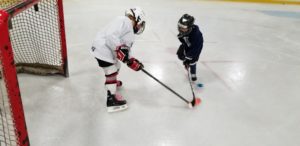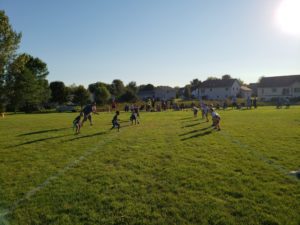I grew up playing sports and loving them. I tried most sports in one way or another, but became more serious in high school with one sport that I continued into college. My husband also grew up playing sports, both informally with the other kids on his street, and on organized teams. Needless to say, when we had kids, we started playing sports with them.
The bright side of organized sports
There are many wonderful aspects of kids sports and sports in general. First of all, active parents are more likely to have active kids, and kids being active is correlated with many positive outcomes. For example, 1/10 as likely to be obese, 40% high academic test scores, less smoking, drug use (except alcohol), and risky sex, 15% more likely to go to college, and less health costs (Farrey, 2015). There is no doubt that physical activity, whether organized or informal, is great for many kids and adults.
In addition to the physical benefits, there are a number of psychological benefits such as making friends, learning teamwork, learning perseverance, and seeing how practice influences performance. Are sports the only way to build these skills? Of course not, but it is one avenue to build these skills.
The dark side of organized sports
Cost: Organized sports are like business, there is a finite number of customers and they are competing to get their business. Many sports make the introductory lessons very inexpensive to draw kids in, then raise the prices once kids are hooked. Organized sports can become very expensive, very quickly.
Competitiveness: For many adults, competition is fun, so they want to share that with their kids. The problem is that most children don’t have a full understanding of the multiple factors that influence performance (time spent practicing, ability level, physical development, effort…) until they are 10-12 years old. This is why most organizations that advocate for children’s organized sports argue for avoiding the emphasis on competition until they are in middle or high school. The problem? Adults need to remember this. Parents need to calm down and cheer the achievements and the struggles.
Time: Once kids start elementary school, a lot of their time is filled up with school. There is only a limited amount of after school time, so booking it all up with sports can be overwhelmed. Organized sports are good, but it is vital that children have free play time. There needs to be a balance, especially in elementary and middle school.
1. We try our best to stick to one sport at a time to avoid overscheduling the kids, and when there are options, we choose the less intense option. I realize this is easier to do now, when our kids are young. When they get older, we plan to have discussions with the kids about what they want to do and how much time they want to devote to the sport.
2. We will not let our kids specialize in a sport until high school. When kids specialize too young, they have a higher chance of physical injury because not all muscle groups are developed in all sports, so they don’t have well-rounded development. Plus, it takes time to find their niche. There is no need to rush this at a young age.
3. When possible, we choose our local recreation leagues. First, they tend to be less competitive. Second, our kids have met a lot of kids from the neighborhood and formed new friendships.
4. When we talk about their performance, we emphasize improving their skills, not how many goals they scored. We focus on how much improvement they have had with the effort they have put into practice.
5. We make sure that the programs we sign up for are focused on skill building and strive to treat all children fairly. I prefer when the teams are randomly assigned or intentionally made to be as even as possible. As they get older, this is harder to find, but we strive to find teams that are clear about the process for dividing up teams.
6. When we do sign up, we pay attention to what the coaches say and how the organization handles conflicts. They may “say” the right things in their written materials, but we need to make sure they follow through.
These steps have worked well for us so far to help make sure our kids are in the types of programs that support their development, and to make sure they have balance in their lives. What other steps do you take to ensure balance in your kids’ lives?
Finally, there are some great websites that provide more specific suggestions and resources for parents and coaches:
http://www.aspenprojectplay.org/

















